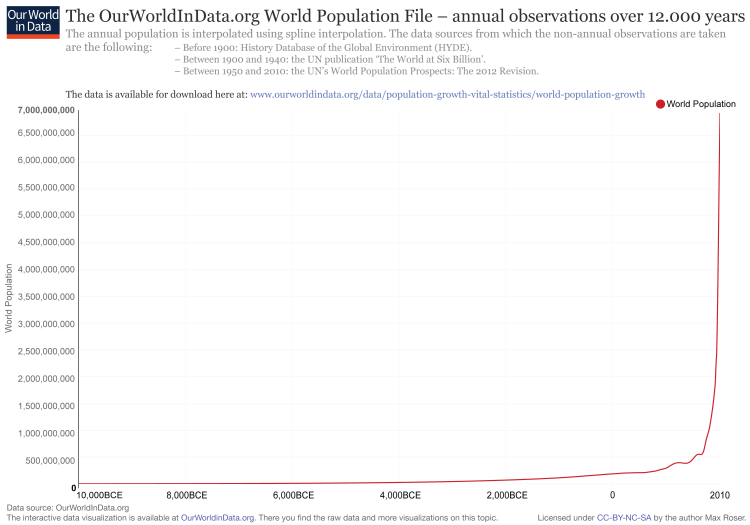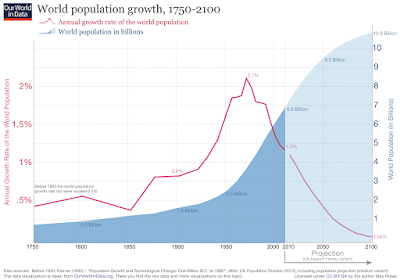Environmentalists, social advocates, and apocalypse-aficionados all enjoy scaring the masses with the idea of the exponential growth of the human population. At first glance, the dire warnings of overpopulation seem completely supported, given the explosion from 2.5 billion people in 1950 to more than 7 billion people today. But is an exponential model, always increasing at an increasing rate (general form: dN/dt = rN), really representative of how we will expand? Intuition says no. There has to be a cap in our growth, right? We cannot keep growing forever. Scientists have been confident of self-limiting growth for centuries. I, for one, like the idea of self-limiting growth, seeing as how the African driver ant queen lays between 3-4 million eggs every month. But here’s the thing: those old-timey predictions of the stabilization of human population failed. A long time ago. In fact, about 5 billion of us should not be here right now, if older predictions were correct. Yet here we are, with roughly 6% of all humans ever born alive right now.

It sure looks exponential, doesn’t it?
But a sharp curve does not mean the math fits.
A wonderful illustration of this is available from Math
Bench. This
tool allows you to find the best fit growth rate over distinct periods: early
(up to 0 CE), mid (0 CE – 1950 CE), and modern (1950-present).
No
exponential model fits that variation! Technology,
it seems, is ruining math. Advances in
food production and medicine (among other things) have allowed for steeper
exponential growth in the modern era.
Ok, you
might be saying, so an exponential function might be able to fit if we just
look at the post-Industrial Revolution age.
That should be all that matters, since we can’t really say that human
civilization is anything like it was in the Bronze Age, right? If you think so, you should be investing
heavily in the Mars colony, because the carrying capacity of Earth will smack
us in the face if we’re not careful. The
most cheerful estimates cap us off at 40 billion, and that is with every human
being surviving with subsistence living (not to mention a civilization of
vegetarians). Good luck with that one,
America. If everyone on Earth lived like
us, we’d have to get by with only 2 billion of our closest friends.
Enter the logistic model, or dN/dt=rN(1-N/K),
where K is carrying capacity. With such divergent beliefs of the true carrying
capacity of Earth (2 – 40 billion), any attempt at a logistic model starts off
handicapped. Couple that with the fact
that all logistic models have an inflection point somewhere (the point at which
growth starts increasing at a decreasing rate), and the problems with fitting a
logistic model multiply. If we look only
at the very recent past, we can squint and see that the inflection point has
been passed (which is by definition at a population of K/2).
If we zoom out, that inflection point
is hard to see:
The best-fit model seems to depend on
our time frame. All because technology
screwed up the statistics.
What does that mean for us? Without technological innovation, carrying
capacity would likely be around 2 billion.
Remember that Mars mission you should be supporting? If we go beyond Earth’s resources, carrying
capacity could become irrelevant (at least in the short term). New worlds, or
even just an influx of new resources (think about Ceres, possibly holding
more freshwater than
all of Earth) changes the game, and perhaps the
model. Without scarcity, there need not
be an inflection point. The more
frightened we become of the impending apocalypse, the more innovative we will
be. In the contest between exponential
and logistic functions to explain human population growth, every new extra-planetary
mission is a point for the exponential model.



If ever a question needed a Bayesian approach to model, when the apocalypse happens is surely it.
ReplyDeleteI realize this was only a minor point of your post, but I thought it was shocking how big of a difference the change in time scale makes in how the curve of the graph is perceived. It is an important reminder that it is always a good idea to consider carefully how you view graphical representations of your data throughout the model fitting process.
ReplyDeleteSo what if population growth will really be sigmoidal (assuming that we never make it to Mars and are confined to our Earthling definition indefinitely)? Such that right now we are is the upswing using the curtails of technology to rapidly accelerate population growth. But at one point our resources will be insufficient, even with the stretching made capable by technology. At this point growth will plateau. What if we compared the projected population growth curve of the world population to consumption of our irreplaceable resources? Might we then be able to project a plateau?
ReplyDeleteI think Nathan's point is still a poignant one. Current predictive modeling fails at taking into account the "evolution" of integral variables like technology which when coupled with the decreasing fertility rate for the foreseeable future makes the timeline of human survival not only hard to predict, but one could at least gleam that doomsday scenarios of the disappearance of natural resources due to overpopulation may be becoming increasingly unlikely, at least with regards to the timeline of humanity. Your point about the inevitability of natural resources running out is heard but why is it relevant of technological advances would bring us to a point where we could outsource the required natural resources or to colonize sites that increase are total resource pool. What if technological advances move us into a total state of renewable energy consumption in the future, how does our current predictive modeling possibly anticipate such a large-scale shift in total resource consumption? Maybe I'm just bullish on the trajectory of technological advancement being a savior for humanity's long-term future, but our rapid progression, just for example in one field, in treating leukemia's with arsenic in the 1920s to personalized immunotherapy in 2016 is a testament to the rate of our advancement which to me is a far more telling predictor of our likelihood of survival. I would highly recommend http://www.amazon.com/What-Technology-Wants-Kevin-Kelly/dp/0143120174 for an interesting read on what technology has done, is doing, and will do in an increasingly biological manner...
Delete